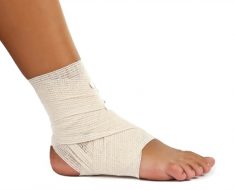How GARLIC could treat Lyme disease: Oils from the pungent bulb kill the bacteria behind the infection, tests show
- John Hopkins scientists tested 35 essential oils against Borrelia burgdorferi
- Included thyme, cinammon, allspice, cumin, myrrh and lemongrass
- Killed off ‘persister cells’, which make the bacteria resistant to antibiotics
2
View
comments
Garlic could treat Lyme disease, scientists claim.
Tests have shown oils from the food staple and other common herbs kill the bacteria behind the infection.
Scientists tested 35 essential oils against the bacteria Borrelia burgdorferi, which causes Lyme disease.
Ten of them – including garlic, thyme, cinammon, allspice and cumin – killed off so-called ‘persister cells’.


Garlic could treat Lyme disease as scientists discover oils from the food staple and other common herbs kill the bacteria behind the condition, John Hopkins scientists found (stock)
Persister cells are thought to make the bacteria more resistant to antibiotics and may be why up to 20 per cent of patients experience pain and fatigue even after they have been treated.
Lyme disease is a tick-borne illness that results from the bite of black-legged ticks, according to the Center for Disease Control and Prevention.
Tick-borne diseases, such as Lyme disease, are on the rise, with 59,349 reported cases in the US last year compared to 48,610 in 2016. Experts put this down to just better reporting.
But the true numbers are likely to be even higher due to many cases going undiagnosed.
The John Hopkins University researchers estimate around 300,000 likely become infected every year in the US. Between 2,000 and 3,000 new cases occur every year in the UK.
Early symptoms include a red bump at the site of the tick bite followed by chills, headache, fever, joint pain and muscle weakness three-to-30 days later.
-
 Chemicals found in perfume, hand creams and body lotion may…
Chemicals found in perfume, hand creams and body lotion may…  Are statins overprescribed? Study warns the risks of the…
Are statins overprescribed? Study warns the risks of the…  Pregnancy brain IS real: It changes how women’s brains are…
Pregnancy brain IS real: It changes how women’s brains are…  The ‘healthy’ oat biscuits with TWO teaspoons of sugar! We…
The ‘healthy’ oat biscuits with TWO teaspoons of sugar! We…
Share this article
In the days and months after the bite, people may suffer from severe joint pain, shortness of breath, nerve pain and short-term memory, according to the CDC.
Although for most a course of antibiotics clears up the infection within two-to-four weeks, 36 per cent of patients experience lasting symptoms, such as joint pain and fatigue, even six months on.
These patients suffer from ‘post-treatment Lyme disease’ which is thought to be caused by a combination of a weak immune system, subsequent tissue damage and lingering infection.
It is unclear exactly why this occurs, however, B. burgdorferi has been shown to have slow-growing persister cells that are more resistant to antibiotics.
WHAT CELEBRITIES HAVE BATTLED LYME DISEASE?
Country legend Shania Twain had to retrain her voice after she developed dysphonia – affects the muscles of the larynx – as a result of the Lyme disease she contracted during her 2003 Up! tour.
In response to rumours she was in rehab, Sk8er Boi singer Avril Lavigne revealed she actually spent five months bedridden as a result of Lyme disease in 2015.
Avril even said she ‘accepted death’ when she could ‘feel her body shutting down’. Now recovered, she reflects on the period as a ‘battle of a lifetime’.
Real Housewives of Beverly Hills star Yolanda Hadid has been battling Lyme disease remissions for years after finally being diagnosed in 2012. Doctors previously thought it was ME.
And her daughter Bella Hadid, who models for Victoria’s Secret, also suffers from the ‘invisible illness’ and has said she does not know what it is like to wake up without bone pain or brain fog.
Hollywood actor Ben Stiller was diagnosed in 2010. Although symptom free, he has said it ‘never leaves your system’.
Results of the Johns Hopkins study showed that at a concentration of just 0.1 per cent the following essentials oils had ‘strong activity’ against B. burgdorferi in the lab, compared to the antibiotic control doxycycline:
- Garlic
- Allspice
- Cumin
- Palmarosa – Indian species of lemongrass
- Plant Hedychium spicatum
- Myrrh
- Amyris
- Thyme
- Aromatic litsea
- Lemon eucalyptus
The top six showed ‘remarkable activity’, with only dead cells remaining in the petri dish.
And at just 0.05 per cent, four essential oils – garlic, allspice, lemongrass and cinammon – were still effective.
As well as targeting the slow-growing stage, cinammon even killed replicating B. burgdorferi at a concentration of 0.02 per cent.
The study was published in the journal Antibiotics and led by Dr Ying Zhang, professor of molecular microbiology and immunology at John Hopkins.
These essential oils are thought to target the persister cells’ membrane and could be used in combination with antibiotics, which kill the fast-growing form of the bacteria, to treat the disease.
Although the antibiotic daptomycin has good persister activity, it is expensive and intravenous, which makes it difficulty to administer.
The researchers add further studies are required to determine the ingredients in essential oils that target B. burgdorferi.
Garlic has been used throughout history for its antimicrobial properties, with it first being described in ancient China and more recently by Louis Pasteur in 1858.
WHAT IS LYME DISEASE?
Lyme disease is caused by a bacteria that is transmitted to humans through the bite of infected black-legged ticks.
The most common symptoms of the disease are fever, headache, fatigue and a skin rash called erythema migrans.
The disease can typically be treated by several weeks of oral antibiotics.
But if left untreated, the infection can spread to the joints, heart and nervous symptoms and be deadly.
WHAT HAPPENS WHEN YOU ARE INFECTED?
During the first three to 30 days of infection, these symptoms may occur:
- Fever
- Chills
- Headache
- Fatigue
- Muscle and joint aches
- Swollen lymph nodes
- Erythema migrans (EM) rash
The rash occurs in approximately 80 per cent of infected people.
It can expand to up to 12 inches (30 cm), eventually clearing and giving off the appearance of a target or a ‘bull’s-eye’.
Later symptoms of Lyme disease include:
- Severe headaches and neck stiffness
- Additional rashes
- Arthritis with joint pain and swelling
- Facial or Bell’s palsy
- Heart palpitations
- Problems with short-term memory
- Nerve pain
Source: CDC
Source: Read Full Article





